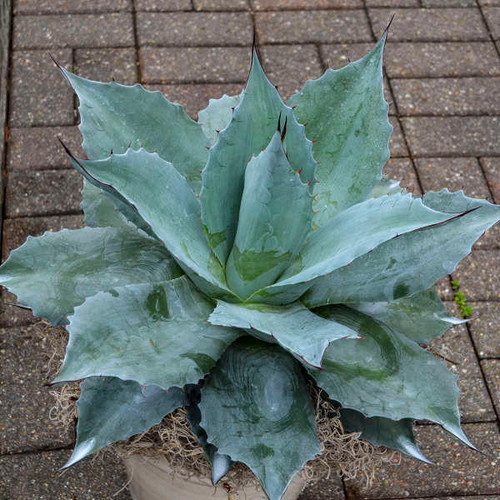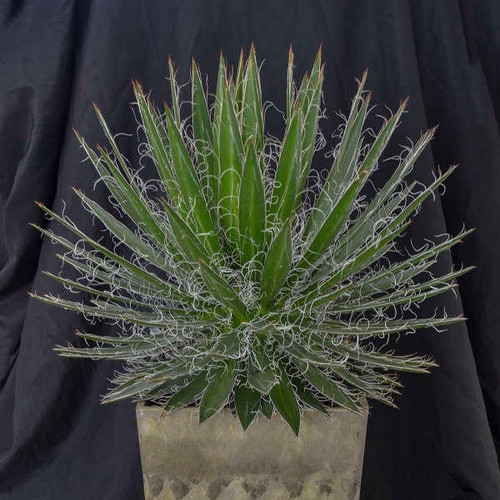Product Description
Agave parryi ssp. truncata (72)ct Flat
Common Name: Agave, Hardy Century Plant
This species is often described as the most beautiful of all Agaves, but with so many gorgeous specimens out there, how can you pick just one favorite? The beauty and grace of this formal looking Agave is undeniable.
Its wide, rounded, blue-grey leaves form a perfectly symmetrical, rounded rosette just about as wide as it is tall. Each leaf ends in a dark, pointed, terminal spike.
When the plant reaches maturity, it produces an incredibly tall flower spike that can reach heights of 20 feet. Agaves typically flower only once every 15-25 years. Though the mother plant dies after flowering, it produces an abundance of offspring during its lifetime so you should have plenty to spread around the garden or to share with friends.
Agave is a tender perennial or "temperennial" succulent plant that grows best in full sun. Light afternoon shade is recommended in the hottest parts of the country. Plant in well-drained, dry to average soil in containers just slightly wider than the width of the rosette or plant directly in the ground. In summer when the plants are actively growing, they appreciate a bit of supplemental watering and half-strength fertilizer. They should be grown dry in winter. Agave is a slower grower, so it will not quickly overtake the space it is allotted in the landscape.
Height: 18.0 Inches
Spread: 18.0 Inches
Hardiness Zones: (6),7,8,9
Foliage Color: Blue shades
Full Sun (> 6 hrs. Direct Sun)
Low to Average Water Needs
Poor to Average Soil Quality
Deer and Rabbit Resistant
Growth Rate: Slow
Container, Drought Tolerant, Attractive Foliage, Specimen, Native to North America
The Artichoke Agave
Agave parryi ssp. truncata, commonly known as the Artichoke Agave, is a captivating succulent that has earned a reputation for its unique beauty and hardiness. This slow-growing evergreen perennial forms tight rosettes of broad, silvery-blue leaves, each tipped with sharp spines and adorned with reddish-brown teeth. Originally discovered in an oak-juniper woodland in the Sierra Papanton, Durango, Mexico, this agave is native to the southwestern United States and Mexico, where it thrives in arid environments. It is remarkably adaptable, withstanding temperatures as low as 10°F. With its distinctive appearance and low-maintenance nature, the Artichoke Agave has become a sought-after gem for gardeners and landscapers seeking to add a touch of the desert's enduring charm to their creations.
The Artichoke Agave is instantly recognizable due to its compact, symmetrical rosettes. The leaves are thick and fleshy, boasting a captivating blue-gray coloration that adds a touch of elegance to any setting. These wide, paddle-shaped leaves have truncated ends, which creates a unique, almost geometric appearance. Adding to its allure, each leaf is edged with sharp spines and adorned with reddish-brown teeth, which become more pronounced on older rosettes. A distinctive feature of this agave is the "V-shaped notch" at the tips of its leaves.
This agave is relatively small, typically reaching a height of 2 to 3 feet and a width of 2 to 4 feet. When mature, typically after 10 years or more, it produces a magnificent flowering spike that can reach up to 15 feet tall, bearing dense clusters of yellow flowers. This blooming event, however, marks the end of the plant's life cycle, as it is monocarpic. Monocarpic plants, such as the Artichoke Agave, flower only once in their lifetime and then die. Fortunately, it produces offsets, or "pups," that continue to grow and form colonies, ensuring the continuation of its captivating presence.
In addition to the typical Artichoke Agave, there is a highly sought-after cultivar known as 'Huntington.' This clone, grown at the Huntington Botanical Garden since 1951, is distinguished by its pale blue-gray leaves with widely spaced small teeth and a wavy terminal spine. The spines on new leaves are a dark reddish-brown, which fades to gray on older leaves. Another intriguing feature of 'Huntington' is the imprint of the thorny leaf margins of the previous outer leaf-bud on the lower surfaces of its leaves.
The Artichoke Agave is a slow-growing succulent, adding only a few inches in size each year. It prefers full sun and well-drained soil and is exceptionally drought-tolerant. While it can tolerate some shade, it thrives in bright, sunny locations. Interestingly, its growth rate varies slightly depending on the region. In the Palm Springs area, expect a few inches of growth per year, while in more temperate regions, it grows a bit faster. It is also remarkably cold-hardy, able to withstand temperatures down to 10°F for short periods. This agave is not a prolific producer of offsets, which contributes to its low-maintenance nature.
Care Requirements Caring for an Artichoke Agave is relatively straightforward. Here are some key care requirements:
- Soil: Well-draining soil is crucial. A mix of sandy or gravelly soil with organic matter is ideal. It can tolerate poor soils, including sandy and rocky conditions.
- Watering: Water deeply but infrequently, allowing the soil to dry out completely between waterings. Reduce watering during the winter months. Overwatering can lead to drooping and a squishy texture, especially at the base of the plant, while underwatering can cause shriveling and drying of the leaves.
- Sunlight: Provide at least 6 to 8 hours of direct sunlight per day. In hotter climates, some afternoon shade may be beneficial.
- Fertilizer: Fertilizer is not typically required, but a balanced, slow-release fertilizer can be applied in spring if desired.
- Pruning: Minimal pruning is needed. Remove any dead or damaged leaves, as necessary.
- Pests and Diseases: This agave is generally pest-resistant but can be susceptible to scale insects and agave snout weevil infestation. Monitor the plant regularly and treat any infestations promptly.
- Caution: When handling this agave, be sure to wear safety gear, such as gloves and safety glasses, due to its sharp spines. The sap can also irritate the skin, so it is best to avoid contact.
- Winter Care: They should be grown dry in winter.
Hardiness Zones and Ideal Growing Conditions The Artichoke Agave is hardy in USDA zones 7 to 12. It thrives in hot, dry climates with full sun and well-drained soil. It is an excellent choice for xeriscaping and drought-tolerant gardens. When grown indoors, it requires a bright window position with as much natural light as possible.
Landscaping Settings The Artichoke Agave's striking form and architectural presence make it a versatile addition to various landscaping settings. Here are some ideas:
- Accent Plant: Its unique shape and color make it an ideal accent plant in rock gardens, succulent gardens, or Mediterranean gardens. Imagine it nestled among weathered stones, its silvery-blue rosettes echoing the hues of the sky or adding a touch of drama to a dry creek bed.
- Containers: It thrives in containers, adding a touch of sophistication to patios, balconies, or indoor spaces. Picture it as a centerpiece on a patio table, its sculptural form drawing the eye and adding a touch of the desert's rugged beauty to your outdoor living area.
- Mass Plantings: When planted in masses, it creates a dramatic groundcover with a unique texture. Envision a hillside swathed in its silvery-blue rosettes, creating a tapestry of texture and color that evokes the vastness of the desert landscape.
- Borders: Its compact size makes it suitable for borders, where it can be combined with other drought-tolerant plants. Imagine it lining a walkway, its sharp spines providing a natural barrier while its blue-gray foliage contrasts beautifully with the vibrant blooms of companion plants.
- Wildlife Garden: The Artichoke Agave attracts hummingbirds and birds, making it a welcome addition to wildlife gardens.
The Agave parryi ssp. truncata, or Artichoke Agave, is a remarkable succulent that offers both beauty and resilience. Its distinctive appearance, low-maintenance nature, and adaptability to various growing conditions make it a valuable asset to any garden or landscape. Whether used as an accent plant, a container specimen, or a striking groundcover, the Artichoke Agave is sure to capture attention and provide years of enjoyment. With its captivating beauty and ability to evoke a sense of the desert landscape, it is a true gem for gardening enthusiasts seeking to create a unique and low-maintenance garden. This long-lived succulent, with a lifespan of approximately 10 years under ideal conditions , is a testament to the enduring allure of the desert flora.
Other Details
The most important part of the plant is its root system. Healthy roots are the foundation of a healthy, vibrant plant. The type of plug container used is based on the specific needs of the plants. Perennials offered as bare root traditionally perform better when planted as bare root.Planted in a specialized mix, potted plants have well established root systems. Top growth stage will vary depending on the current life cycle and time of year when shipped. In Winter and early Spring dormant plants may be shipped. Dormant plants may be planted right away, even before the last frost date.
Most bare root varieties are field grown for at least one season, though Hemerocallis and Hosta are grown for two seasons. The bulk of the soil is removed during the harvesting process and the tops of most varieties are trimmed back to the crown. They are graded, packed in shredded aspen or sphagnum moss and stored in freezers until ready to be shipped.
See our Container Sizes and Bare Root Perennials pages for more information.
Plant information and care is provided in the Overview section, Plant Genus Page and general information is provided in the Planting Care & Guides. Additional questions can be asked on each Plant page.
Plant Spacing: Using the maximum mature spread or width of a plant to guide spacing, ensures space to grow to full size. To fill an area sooner, plant them closer together. Just remember, future thinning or transplanting may be needed.
Water: Keep a close eye on newly planted perennials, especially throughout the first growing year. Most early plant loss is due to too much or too little water!
















